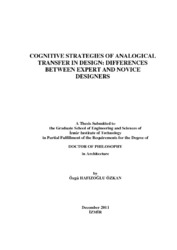Please use this identifier to cite or link to this item:
https://hdl.handle.net/11147/2906Full metadata record
| DC Field | Value | Language |
|---|---|---|
| dc.contributor.advisor | Doğan, Fehmi | en |
| dc.contributor.author | Hafızoğu Özkan, Özgü | - |
| dc.date.accessioned | 2014-07-22T13:48:35Z | - |
| dc.date.available | 2014-07-22T13:48:35Z | - |
| dc.date.issued | 2011-12 | en |
| dc.identifier.uri | http://hdl.handle.net/11147/2906 | - |
| dc.description | Thesis (Doctoral)--İzmir Institute of Technology, Architecture, İzmir, 2011 | en |
| dc.description | Includes bibliographical references (leaves: 106-120) | en |
| dc.description | Text in English; Abstract: Turkish and English | en |
| dc.description | xiv, 131 leaves | en |
| dc.description | Full text release delayed at author's request until 2015.01.19 | en |
| dc.description.abstract | Analogy is an essential tool of human cognition that enables connecting two systems with casual relations. Previous research in analogy has focused primarily on role of analogy in creative domains. In literature there is lack in understanding the different levels of expertise and the remoteness of source and target domains; how these parameters impact the nature of analogies and stages of analogical transfer in a more holistic view. Thus we aimed to understand analogy mechanism to develop design education for achieving creative solutions transferring interdisciplinary knowledge effectively in the light of cognitive differences of novice and expert designers. An experimental study is conducted to understand the mechanism of analogy in design. 40 source domains were manipulated in four categories; (1) bus stop, (2) architecture, (3) artifacts, (4) nature. 373 students and 22 expert designers attended to the experiment. The experiment focused on first; the selecting one of the source domain groups and an example from this group, and second; designing a bus stop by analogical reasoning. In this research first we analyzed the relation between expertise levels and distance of source domains. Second, we analyzed the relation between expertise levels and the level of similarity. Third, we analyzed overall relations of these parameters; how local, regional, remote and long-distant analogies influence the level of similarity. Finally, how expert vs. novice retrieval of source domain affected the creative analogy process in design. Findings lead us to understand relation between expertise, the acquisition of knowledge and creative thought. Results showed that expert designers generally selected local domain which is the less potential source domain for creativity, and novice designers generally selected long-distant domain which is the most potential source domains for creativity. However, in design process analogy and literal similarity increased parallel to the expertise levels contrary to anomaly and mere appearance similarity. Education develops the ability of analogical reasoning. However it conditioned the designers in the selection of source domains. | en |
| dc.language.iso | en | en_US |
| dc.publisher | Izmir Institute of Technology | en |
| dc.rights | info:eu-repo/semantics/openAccess | en_US |
| dc.subject.lcsh | Reasoning | en |
| dc.subject.lcsh | Analogy | en |
| dc.subject.lcsh | Creative ability | en |
| dc.subject.lcsh | Knowledge management | en |
| dc.title | Cognitive strategies of analogical transfer in design: Differences between expert and novice designers | en_US |
| dc.type | Doctoral Thesis | en_US |
| dc.department | Thesis (Doctoral)--İzmir Institute of Technology, Architecture | en_US |
| dc.relation.publicationcategory | Tez | en_US |
| item.languageiso639-1 | en | - |
| item.fulltext | With Fulltext | - |
| item.openairecristype | http://purl.org/coar/resource_type/c_18cf | - |
| item.openairetype | Doctoral Thesis | - |
| item.grantfulltext | open | - |
| item.cerifentitytype | Publications | - |
| Appears in Collections: | Phd Degree / Doktora | |
Files in This Item:
| File | Description | Size | Format | |
|---|---|---|---|---|
| 421728.pdf | DoctoralThesis | 3.42 MB | Adobe PDF |  View/Open |
CORE Recommender
Page view(s)
284
checked on Jul 22, 2024
Download(s)
110
checked on Jul 22, 2024
Google ScholarTM
Check
Items in GCRIS Repository are protected by copyright, with all rights reserved, unless otherwise indicated.